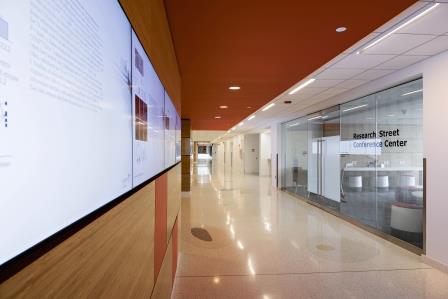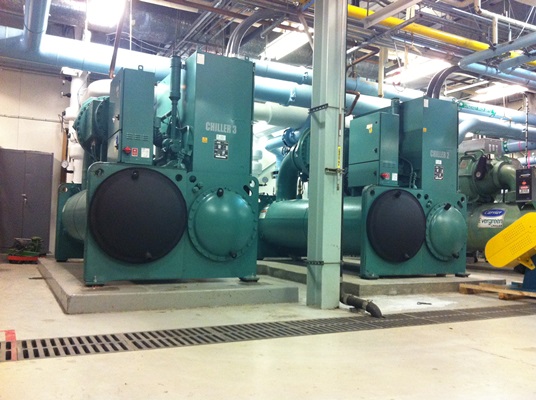
Cyma Builders was selected by this Fortune 500 Pharmaceutical company to renovate the main corridor at their R&D facility in Spring House, PA, which serves as the spine connecting all buildings onsite. The project entailed high-end architectural, branding and AV upgrades representative of the site’s science based functions and corporate culture. The project was logistically constrained due to the fact that the corridor needed to remain active during normal business hours. As such, the team at Cyma developed a plan to phase the work and conduct all construction activities during off hours. Essential to this strategy was ensuring any work performed during a shift could be made safe for employee traffic the next business day. Upgrade included installation of high-end mill work feature wall, new ceilings and glass storefront to segregate adjacent areas. Renovations were also performed at the adjacent conference center to match the new Research Street environment. Additionally, a new terrazzo floor was installed throughout the renovated area, inclusive of custom metal inserts illustrative DNA and cells. All work was performed on time, within budget and without impact to daily site operations.

The ALZA plant in Vacaville, CA is an active manufacturing facility critical to this Fortune 500 Pharmaceutical company’s global supply chain. Project Hot & Project Cold were energy efficiency upgrade projects designed to optimize plant efficiency and reduce the overall cost of operational utilities. Current and future loads were examined to incorporate additional capacity required by an ongoing Master Plan. The work was funded by the Fortune 500 Pharmaceutical company as part of a corporate programs to authorize any potential projects that could illustrate a 10 year return on investment. All work on the projects was executed under active facility conditions with careful coordination of system shutdowns and tie-ins when necessary. Project Cold included the replacement of two (2) existing chillers that were original to the building, with two (2) new 500 ton Johnson Controls centrifugal chillers. All chilled water work was performed during the cooler season to minimize risk while the system was operating without redundancy. In addition to the chillers, a temporary cooling tower was replaced with a new 500 ton single-cell Marley cooling tower adjacent to the existing lineup to avoid capacity issues with the condenser water system. A permanent header configuration was also extended to pick up the condensate supply/return connections at the new cooling tower. Additionally, new concrete foundations and structural steel supports were installed to accommodate the exterior cooling tower. The chilled water distribution system was also upgraded at all points of use, namely AHU chilled water coils, with automatic two-way valves. These valves were controlled by the new Optimum Energy system, and modulated based off system needs. A bypass line was also installed to allow the chilled water system to utilize free cooling when conditions allowed. Project Hot included the installation of one (1) new 6,000 MBH Cleaver Brooks heating hot water boiler to accommodate future capacity and allow for greater turndown ratio based on system demands. The heating hot water system was also upgraded at all points of use, namely AHU heating coils, with automatic two-way valves. These valves were controlled by the new Optimum Energy system, and modulated based off system needs. In addition, the existing thermal oxidizers were replaced for the plant to appropriately size the equipment based off current facility loads. All Project Hot & Project Cold project work was complete with Optimum Energy efficiency controls, and fully coordinate with an ongoing Honeywell BAS upgrade. The Optimum Energy system was fully integrated with the new BAS controls to allow for field monitoring of temperature data and control of the central utility infrastructure. The Optimum Energy system was also installed with a dedicated IT connection to allow for system communication to a remote command center for data collection and auditing. Both Project Hot and Project Cold were successfully implemented and recognized the original energy efficiency goals of the project.


